Florian Stimberg
Dj
Imagen 3
Aug 13, 2024Abstract:We introduce Imagen 3, a latent diffusion model that generates high quality images from text prompts. We describe our quality and responsibility evaluations. Imagen 3 is preferred over other state-of-the-art (SOTA) models at the time of evaluation. In addition, we discuss issues around safety and representation, as well as methods we used to minimize the potential harm of our models.
Benchmarking Robustness to Adversarial Image Obfuscations
Jan 30, 2023



Abstract:Automated content filtering and moderation is an important tool that allows online platforms to build striving user communities that facilitate cooperation and prevent abuse. Unfortunately, resourceful actors try to bypass automated filters in a bid to post content that violate platform policies and codes of conduct. To reach this goal, these malicious actors may obfuscate policy violating images (e.g. overlay harmful images by carefully selected benign images or visual patterns) to prevent machine learning models from reaching the correct decision. In this paper, we invite researchers to tackle this specific issue and present a new image benchmark. This benchmark, based on ImageNet, simulates the type of obfuscations created by malicious actors. It goes beyond ImageNet-$\textrm{C}$ and ImageNet-$\bar{\textrm{C}}$ by proposing general, drastic, adversarial modifications that preserve the original content intent. It aims to tackle a more common adversarial threat than the one considered by $\ell_p$-norm bounded adversaries. We evaluate 33 pretrained models on the benchmark and train models with different augmentations, architectures and training methods on subsets of the obfuscations to measure generalization. We hope this benchmark will encourage researchers to test their models and methods and try to find new approaches that are more robust to these obfuscations.
Data Augmentation Can Improve Robustness
Nov 09, 2021

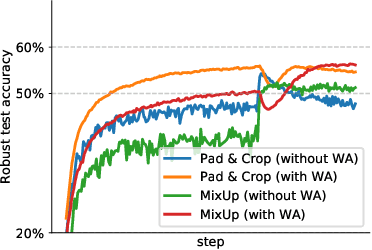
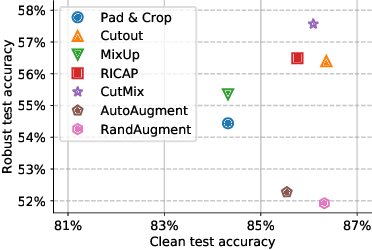
Abstract:Adversarial training suffers from robust overfitting, a phenomenon where the robust test accuracy starts to decrease during training. In this paper, we focus on reducing robust overfitting by using common data augmentation schemes. We demonstrate that, contrary to previous findings, when combined with model weight averaging, data augmentation can significantly boost robust accuracy. Furthermore, we compare various augmentations techniques and observe that spatial composition techniques work the best for adversarial training. Finally, we evaluate our approach on CIFAR-10 against $\ell_\infty$ and $\ell_2$ norm-bounded perturbations of size $\epsilon = 8/255$ and $\epsilon = 128/255$, respectively. We show large absolute improvements of +2.93% and +2.16% in robust accuracy compared to previous state-of-the-art methods. In particular, against $\ell_\infty$ norm-bounded perturbations of size $\epsilon = 8/255$, our model reaches 60.07% robust accuracy without using any external data. We also achieve a significant performance boost with this approach while using other architectures and datasets such as CIFAR-100, SVHN and TinyImageNet.
A Fine-Grained Analysis on Distribution Shift
Oct 21, 2021

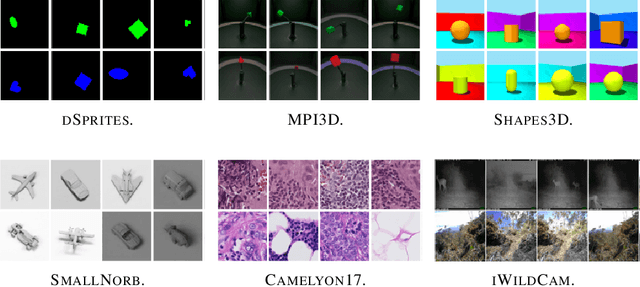

Abstract:Robustness to distribution shifts is critical for deploying machine learning models in the real world. Despite this necessity, there has been little work in defining the underlying mechanisms that cause these shifts and evaluating the robustness of algorithms across multiple, different distribution shifts. To this end, we introduce a framework that enables fine-grained analysis of various distribution shifts. We provide a holistic analysis of current state-of-the-art methods by evaluating 19 distinct methods grouped into five categories across both synthetic and real-world datasets. Overall, we train more than 85K models. Our experimental framework can be easily extended to include new methods, shifts, and datasets. We find, unlike previous work~\citep{Gulrajani20}, that progress has been made over a standard ERM baseline; in particular, pretraining and augmentations (learned or heuristic) offer large gains in many cases. However, the best methods are not consistent over different datasets and shifts.
Improving Robustness using Generated Data
Oct 18, 2021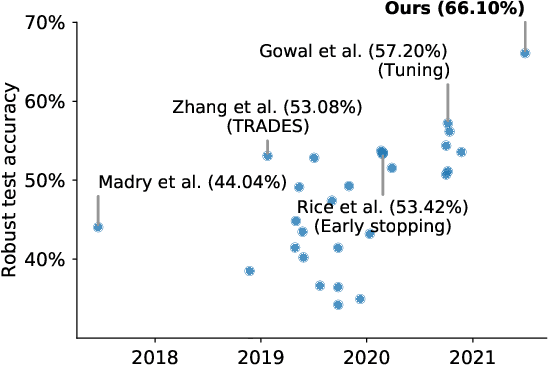

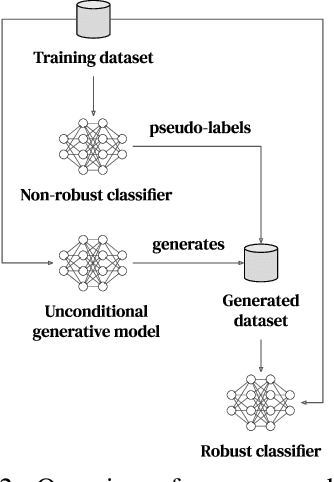
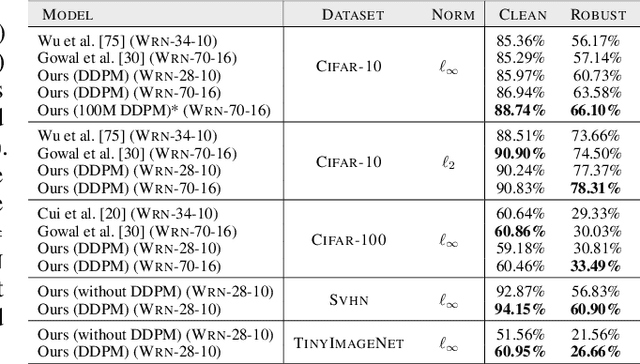
Abstract:Recent work argues that robust training requires substantially larger datasets than those required for standard classification. On CIFAR-10 and CIFAR-100, this translates into a sizable robust-accuracy gap between models trained solely on data from the original training set and those trained with additional data extracted from the "80 Million Tiny Images" dataset (TI-80M). In this paper, we explore how generative models trained solely on the original training set can be leveraged to artificially increase the size of the original training set and improve adversarial robustness to $\ell_p$ norm-bounded perturbations. We identify the sufficient conditions under which incorporating additional generated data can improve robustness, and demonstrate that it is possible to significantly reduce the robust-accuracy gap to models trained with additional real data. Surprisingly, we even show that even the addition of non-realistic random data (generated by Gaussian sampling) can improve robustness. We evaluate our approach on CIFAR-10, CIFAR-100, SVHN and TinyImageNet against $\ell_\infty$ and $\ell_2$ norm-bounded perturbations of size $\epsilon = 8/255$ and $\epsilon = 128/255$, respectively. We show large absolute improvements in robust accuracy compared to previous state-of-the-art methods. Against $\ell_\infty$ norm-bounded perturbations of size $\epsilon = 8/255$, our models achieve 66.10% and 33.49% robust accuracy on CIFAR-10 and CIFAR-100, respectively (improving upon the state-of-the-art by +8.96% and +3.29%). Against $\ell_2$ norm-bounded perturbations of size $\epsilon = 128/255$, our model achieves 78.31% on CIFAR-10 (+3.81%). These results beat most prior works that use external data.
Defending Against Image Corruptions Through Adversarial Augmentations
Apr 20, 2021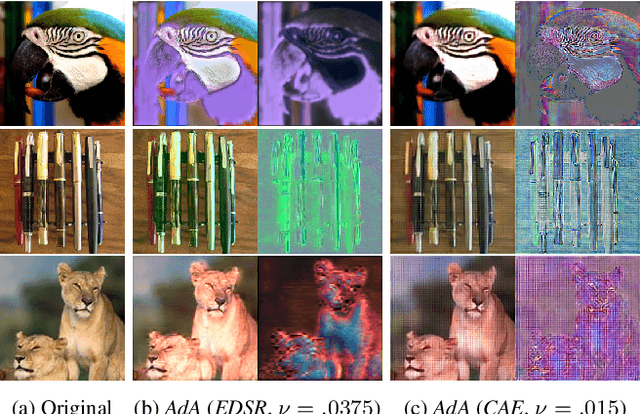

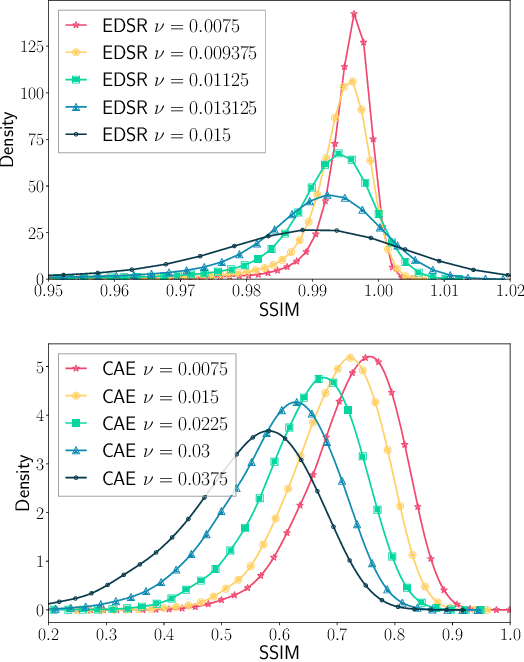

Abstract:Modern neural networks excel at image classification, yet they remain vulnerable to common image corruptions such as blur, speckle noise or fog. Recent methods that focus on this problem, such as AugMix and DeepAugment, introduce defenses that operate in expectation over a distribution of image corruptions. In contrast, the literature on $\ell_p$-norm bounded perturbations focuses on defenses against worst-case corruptions. In this work, we reconcile both approaches by proposing AdversarialAugment, a technique which optimizes the parameters of image-to-image models to generate adversarially corrupted augmented images. We theoretically motivate our method and give sufficient conditions for the consistency of its idealized version as well as that of DeepAugment. Our classifiers improve upon the state-of-the-art on common image corruption benchmarks conducted in expectation on CIFAR-10-C and improve worst-case performance against $\ell_p$-norm bounded perturbations on both CIFAR-10 and ImageNet.
Fixing Data Augmentation to Improve Adversarial Robustness
Mar 02, 2021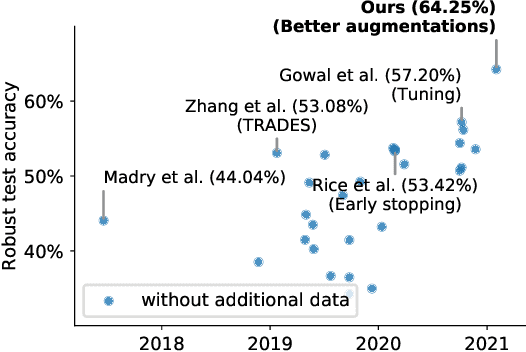
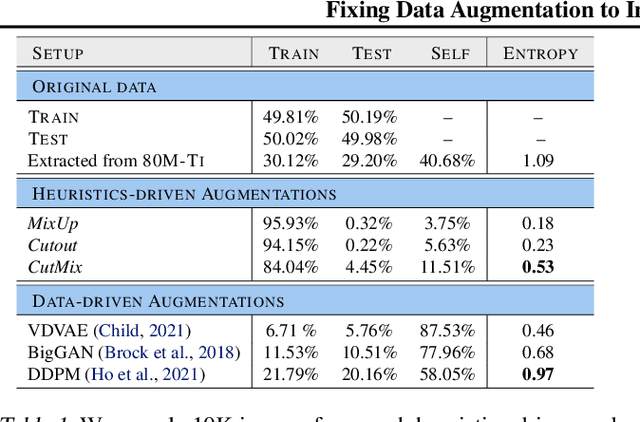

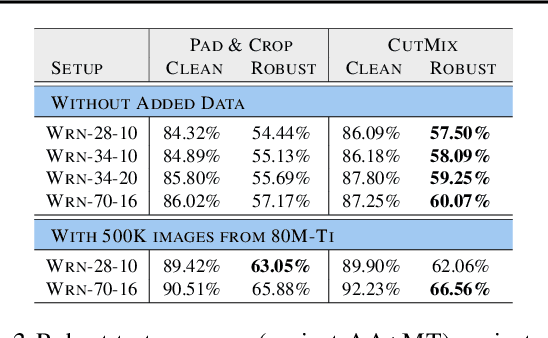
Abstract:Adversarial training suffers from robust overfitting, a phenomenon where the robust test accuracy starts to decrease during training. In this paper, we focus on both heuristics-driven and data-driven augmentations as a means to reduce robust overfitting. First, we demonstrate that, contrary to previous findings, when combined with model weight averaging, data augmentation can significantly boost robust accuracy. Second, we explore how state-of-the-art generative models can be leveraged to artificially increase the size of the training set and further improve adversarial robustness. Finally, we evaluate our approach on CIFAR-10 against $\ell_\infty$ and $\ell_2$ norm-bounded perturbations of size $\epsilon = 8/255$ and $\epsilon = 128/255$, respectively. We show large absolute improvements of +7.06% and +5.88% in robust accuracy compared to previous state-of-the-art methods. In particular, against $\ell_\infty$ norm-bounded perturbations of size $\epsilon = 8/255$, our model reaches 64.20% robust accuracy without using any external data, beating most prior works that use external data.
Efficient Neural Audio Synthesis
Jun 25, 2018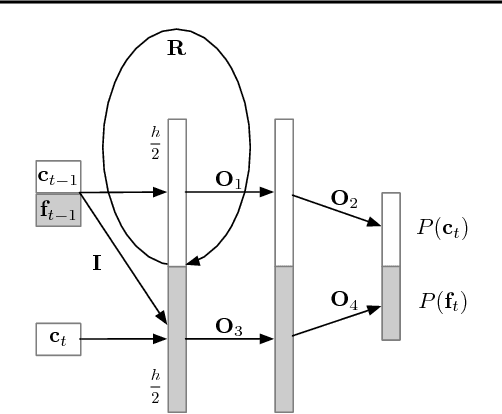


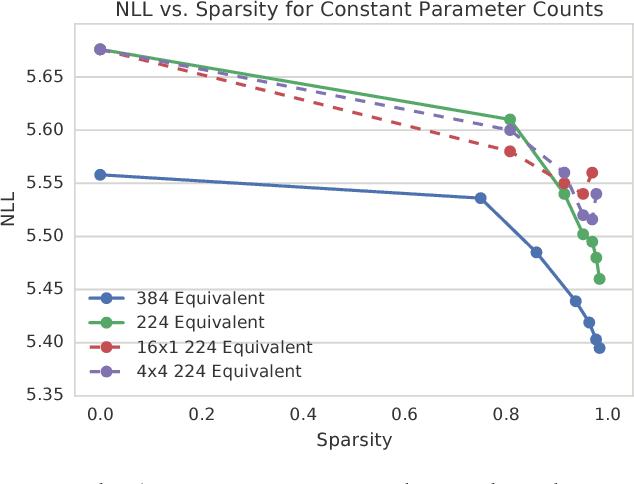
Abstract:Sequential models achieve state-of-the-art results in audio, visual and textual domains with respect to both estimating the data distribution and generating high-quality samples. Efficient sampling for this class of models has however remained an elusive problem. With a focus on text-to-speech synthesis, we describe a set of general techniques for reducing sampling time while maintaining high output quality. We first describe a single-layer recurrent neural network, the WaveRNN, with a dual softmax layer that matches the quality of the state-of-the-art WaveNet model. The compact form of the network makes it possible to generate 24kHz 16-bit audio 4x faster than real time on a GPU. Second, we apply a weight pruning technique to reduce the number of weights in the WaveRNN. We find that, for a constant number of parameters, large sparse networks perform better than small dense networks and this relationship holds for sparsity levels beyond 96%. The small number of weights in a Sparse WaveRNN makes it possible to sample high-fidelity audio on a mobile CPU in real time. Finally, we propose a new generation scheme based on subscaling that folds a long sequence into a batch of shorter sequences and allows one to generate multiple samples at once. The Subscale WaveRNN produces 16 samples per step without loss of quality and offers an orthogonal method for increasing sampling efficiency.
Parallel WaveNet: Fast High-Fidelity Speech Synthesis
Nov 28, 2017
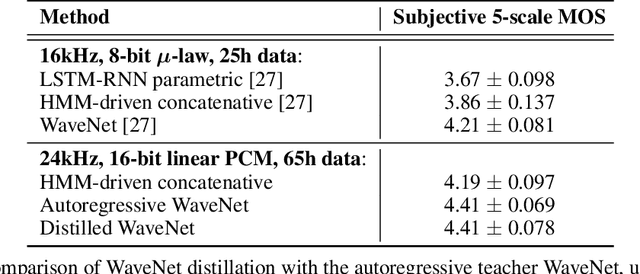
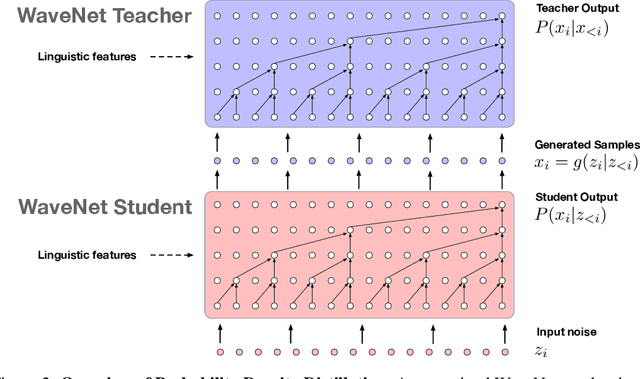

Abstract:The recently-developed WaveNet architecture is the current state of the art in realistic speech synthesis, consistently rated as more natural sounding for many different languages than any previous system. However, because WaveNet relies on sequential generation of one audio sample at a time, it is poorly suited to today's massively parallel computers, and therefore hard to deploy in a real-time production setting. This paper introduces Probability Density Distillation, a new method for training a parallel feed-forward network from a trained WaveNet with no significant difference in quality. The resulting system is capable of generating high-fidelity speech samples at more than 20 times faster than real-time, and is deployed online by Google Assistant, including serving multiple English and Japanese voices.
 Add to Chrome
Add to Chrome Add to Firefox
Add to Firefox Add to Edge
Add to Edge